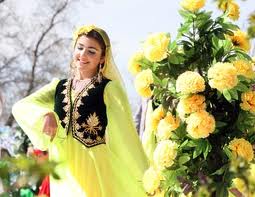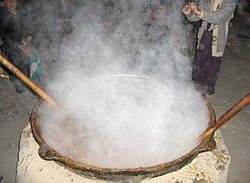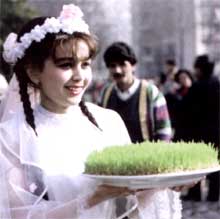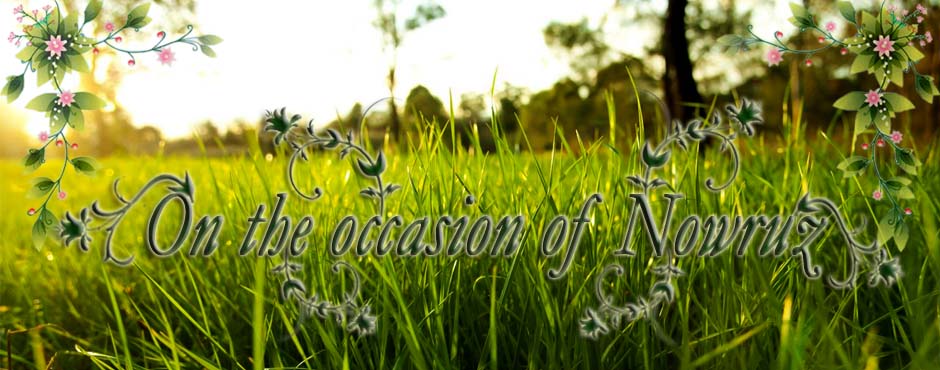
 |
 |
|||

Nowruz (Persian: نوروز, IPA: [nouˈɾuːz], originally "New Day") is the name of the Iranian New Year in Iranian calendars and the corresponding traditional celebrations. Nowruz is also widely referred to as the Persian New Year. Nowruz is celebrated and observed by Iranian peoples and the related cultural continent and has spread in many other parts of the world, including parts of Central Asia, Caucasus, South Asia, Northwestern China, the Crimea and some groups in the Balkans. Nowruz marks the first day of spring and the beginning of the year in Iranian calendar. It is celebrated on the day of the astronomical vernal equinox, which usually occurs on March 21 or the previous/following day depending on where it is observed. As well as being a Zoroastrian holiday and having significance amongst the Zoroastrian ancestors of modern Iranians, the same time is celebrated in parts of the South Asian sub-continent as the new year. The moment the Sun crosses the celestial equator and equalizes night and day is calculated exactly every year and Iranian families gather together to observe the rituals. Originally being a Zoroastrian festival, and the holiest of them all, Nowruz is believed to have been invented by Zoroaster himself, although there is no clear date of origin. Since the Achaemenid era the official year has begun with the New Day when the Sun leaves the zodiac of Pisces and enters the zodiacal sign of Aries, signifying the Spring Equinox.
The Jewish festival of Purim is probably adopted from the Persian New Year. It is also a holy day for Sufis, Ismailis, Alawites, Alevis, and adherents of the Bahá'í Faith. The term Nowruz in writing, first appeared in Persian records in the 2nd century AD, but it was also an important day during the time of the Achaemenids c. 548-330 BC), where kings from different nations under the Persian empire used to bring gifts to the Emperor, also called King of Kings (Shahanshah), of Persia on Nowruz. The significance of Nowruz in the Achaemenid empire was such that the great Persian king Cambyses II's appointment as the king of Babylon was legitimized only after his participation in the New Year festival (Nowruz).
Present value of
Celebrating Nowruz, under various names is widespread in many cultures that made earlier in the zone of influence of the Persian Empire. Later, the spread of this holiday is connected with the influence of Islam. Here is a partial list of options for the name of this holiday in different languages: Науро́з, Навру́з, Ноуру́з, Ноору́з, Науры́з, Навре́з, перс. نوروز — Now ruz, курд. Newroz, тадж. Наврӯз, узб. Наврўз, Navroʻz, азерб. Novruz, туркм. Новруз, Nowruz, каз. Наурыз, уйг. Норуз, кирг. Нооруз, тат. Nəürüz, нәүрүз, тур. Nevruz, крымскотат. Navrez, башк. Näürüz, Нәүрүз, чуваш. Нарăс. He also noted under the local names in other languages.
Now Navruz is celebrated as the beginning of the new year: March 21 in Iran and Afghanistan, as well as a public holiday in Tajikistan, Azerbaijan, Albania, Iraqi Kurdistan, India, Kyrgyzstan, Macedonia, Turkey, Turkmenistan and Uzbekistan - as well as in Kazakhstan - March 21-23. Nowruz is also celebrated at the local level in Tatarstan, Bashkortostan, SUAR.
Nowruz is the beginning of the calendar year as the Baha'is. In the USA March 21 is celebrated as the Day of agriculture.
In some views on the Kurdish people have Navruz word comes from the phrase sex - Niw and day - roj. It is also worth noting that this version has appeared recently and orientalists, linguists, and Kurdish find direct evidence for this theory of the origin of the holiday.
September 30, 2009 Nowruz was included in the UNESCO Representative List of Intangible Cultural Heritage of Humanity together with the other 76 elements of intangible heritage from around the world. The decision to include these 76 elements of intangible heritage was adopted by 24 States Parties to the Intergovernmental Committee for the Safeguarding of Intangible Heritage.
February 19, 2010 at the 64th session of UN General Assembly under agenda item 49 "Culture of Peace" was adopted by consensus a resolution entitled "International Day of Nowruz."
According to the text of the resolution the UN General Assembly:
recognize March 21 as International Day of Nowruz;
Welcomes efforts by Member States in which the celebrated Nowruz, the preservation and development of culture and traditions associated with the Navruz;
To encourage Member States to make efforts to raise awareness of Navruz and organize as necessary an annual event to celebrate this holiday;
Calls upon Member States, in which the celebrated Nowruz, study its history and traditions of this holiday in order to disseminate knowledge among the international community;
Invites interested Member States and the United Nations, in particular its relevant specialized agencies, funds and programs, primarily the United Nations Educational, Scientific and Cultural Organization and relevant international and regional organizations, as well as non-governmental organizations to participate in events held in the States in which the celebrated Nowruz.
Nowruz is translated from Farsi means "new day" - the biggest of all festivals worshiping the sun and fire, noted three millennia ago on the solar calendar, March 21 - the day of the vernal equinox. Nowruz associated with the solar calendar, which appeared among the peoples of Central Asia and Iran's seven thousand years ago, has nothing to do with the Muslim new year. The Muslim calendar - the moon. In his new year begins in the month of Muharam, the first day does not coincide with the beginning of the new year - every year he shifted to 11 days ago. Rooted in the tradition of ancient farmers in the Middle East and Central Asia, the festival not only survived the Arab conquest, but also became an integral part of the culture of many peoples professing Islam. In the CIS, it is celebrated as a national Tatars, Kazakhs, Bashkirs, Kyrgyz, Tajiks, Uzbeks, and many other nations. In some countries, declared a national holiday Navruz, and March 21 - a day off. How could handle Nowruz? Approximately two weeks before the holiday in dishes seeded wheat or lentils. For the holiday of green shoots should reach 5-7 inches, and a decoration for the table, the symbol of the birth of new life, new year. But this does not stop cooking. Closer to the holiday grains germinated once again - to become the basis for a celebratory meal. About a week before Nowruz owners are trying to clean house, repair and whiten it. Be sure to wash the clothes, especially the children - because children are more prone to all evil eye, but the water should be washed off. Even before Islam, the week before Navruz considered dedicated souls of their ancestors. Ancestors commemorated by making offerings to them and asking them for help in the coming year, protection from harm. This is a time of divination. Especially fond of this zanevestivshiesya girls who drop out in the evening through the shoe and head toward his sock define - they remain in the parental home for another year or move into a house betrothed. In addition, the gala evening with the onset of Nowruz made neighbors eavesdrop on conversations through windows or doors, and depending on what he heard pleasant or unpleasant conversation to determine how successful or unsuccessful will the coming year both for listening and for the hosts.
 The holiday begins before dawn, when, wearing new clothes, the whole family gathers for a lighted table. Table for Nowruz cover special and call it "Haft-Sin." Always on the table must be seven (Haft) products whose names begin with the Arabic letter "sin": the seeds of rue - sipand, apple - SEB, the black seeds - siahdane, wild olive - sandzhid, vinegar - Sirko, garlic - seer, and sprouted grains - sabzi. In addition, a mirror is placed on the table and lit by the number of members of the family candles, which can not be put out before they burn down to the end. Required a great holiday bread or tortillas, a bowl of water, which has a green leaf to swim, bowl with rose water, fruit, nuts, almonds, fish, cock, milk, yogurt, cheese, colored eggs. In ancient times each of the components had a special significance for harvest next year, for the fate of family members. Now this symbolism has been lost, but the tradition remained. Preparing risotto. But the key will be on the table and Goodge sumalak. These dishes are prepared every year and only on Nowruz. Begin to cook the evening. All the women in a large family, and in cities - a neighbor, going to a huge boiler, stirring constantly to turn them to a dish is not burnt. Goodge is made of seven kinds of grains with the addition of meat, all boiled soft to the state of a homogeneous mass. A sumalak - a paste, made from sprouted wheat with a little flour and sugar. In the morning, every woman will carry home their share of the total boiler - till the next Navruz. Guests who came to the owner holds out a dish with a barely sprouted grains, which symbolizes the eating of introduction to the revival of all living things. The streets are the artists: both professional and amateur. Sounds fun, compete wits, are the clowns, maskharabozy, heard the song. And when the evening comes, the streets are lit numerous bonfires and jump over them to attend. Until late in the evening continues the fun and laughter, as the morning goes on holiday, although not with the pomp, but just in the home circle.
The holiday begins before dawn, when, wearing new clothes, the whole family gathers for a lighted table. Table for Nowruz cover special and call it "Haft-Sin." Always on the table must be seven (Haft) products whose names begin with the Arabic letter "sin": the seeds of rue - sipand, apple - SEB, the black seeds - siahdane, wild olive - sandzhid, vinegar - Sirko, garlic - seer, and sprouted grains - sabzi. In addition, a mirror is placed on the table and lit by the number of members of the family candles, which can not be put out before they burn down to the end. Required a great holiday bread or tortillas, a bowl of water, which has a green leaf to swim, bowl with rose water, fruit, nuts, almonds, fish, cock, milk, yogurt, cheese, colored eggs. In ancient times each of the components had a special significance for harvest next year, for the fate of family members. Now this symbolism has been lost, but the tradition remained. Preparing risotto. But the key will be on the table and Goodge sumalak. These dishes are prepared every year and only on Nowruz. Begin to cook the evening. All the women in a large family, and in cities - a neighbor, going to a huge boiler, stirring constantly to turn them to a dish is not burnt. Goodge is made of seven kinds of grains with the addition of meat, all boiled soft to the state of a homogeneous mass. A sumalak - a paste, made from sprouted wheat with a little flour and sugar. In the morning, every woman will carry home their share of the total boiler - till the next Navruz. Guests who came to the owner holds out a dish with a barely sprouted grains, which symbolizes the eating of introduction to the revival of all living things. The streets are the artists: both professional and amateur. Sounds fun, compete wits, are the clowns, maskharabozy, heard the song. And when the evening comes, the streets are lit numerous bonfires and jump over them to attend. Until late in the evening continues the fun and laughter, as the morning goes on holiday, although not with the pomp, but just in the home circle.
The word "Nowruz" means "New Day" (from "nav" - a new and "Ruz" - the day). So called the Spring Festival, the first day of the year, the vernal equinox, the most famous and popular festivals of the Persians - the Iranians, Tajiks and Afghans.
The main feast days are 21 and 22 March. In every country and in different regions of the population can celebrate this day differently, but in Tajikistan, mostly celebrating Nowruz 21 to March 24. These are the days of the weekend.
The oldest source, which indicates the celebration of Navruz - the sacred book of Zoroastrians "Avesta". The roots of the holiday goes far back in history to 3000 BC The origins of Nowruz, as described in "Navruznoma" ("The Book of Navruz"), Omar Khayyam, leaves in the days of one of the oldest in the world and the history of the kingdom of the Persians - Peshdodien. In the "Shahnameh," the origin of the holiday is associated with the legendary King Jamshed.
As you know, March 21 - the day of vernal equinox, and the length of day and night is the same - 12 hours. When Jamshed built himself a throne of pure gold (according to legend, this was the first throne in the history of man), and raised it to the highest mountain at sunrise, gold glittered under the sunshine, and it was shining like the sun. This day is called Navruz and began to celebrate it as the beginning of the year. In "Navruzname" says:
"When Jamshed comprehended this day, he called it Navruz and brought him to practice as a holiday. The kings and other people followed him ».
During the celebration of Nowruz organize various activities. In the spirit of folk traditions are organized horse racing, goat (buzhkashi), fighting athletes, buchulbozi, argamchinbozi (skipping rope) lankabozi, tuhmzanak, idgardak.
Much attention is paid to the preparation of the holiday table. On the festive table is not necessary to set only the food. Put on the table dishes, beginning with the letter "c" and "w". Typically, the holiday table is 2 "haftsin" and "haftshin." "Sin" and "tires" - is the name of the letters "c" and "w" in the Persian alphabet, and "Haft" means 7. In Zoroastrianism, and Islam is the sacred number 7.
 In ancient times, was also "haftmim" ("meme" - the name of the letter "m" in Persian alphabet), but because of the many costs of such a table covered with rare. "Haftsin" entered the Arabs, because consumption of wine in Islam is forbidden, but they failed to eradicate the "Haftshin».
In ancient times, was also "haftmim" ("meme" - the name of the letter "m" in Persian alphabet), but because of the many costs of such a table covered with rare. "Haftsin" entered the Arabs, because consumption of wine in Islam is forbidden, but they failed to eradicate the "Haftshin».
On the festive table trying not to put meat and other products made from animals, except for milk.
The symbol of Nowruz and New Year is sumanak (sumalak). How prepared sumanak? Approximately one week before the festival in a pot with a shallow bottom (this can be a plate), soaked wheat. For holiday germinated wheat. It is believed that the longer the seedlings sprouted grains, the larger and better crops will be in the new year. Sprouted grains pounded in a mortar metal, placed in a large kettle, pour water, add flour and cook for 10-12 hours, and stir it all the time. A very sweet thing, even though no sugar is added back. Sumanak should be ready before the sun rises in the main day of celebration. During the preparation of sumanaka women and children sing holiday songs, read poems. Sumanak - this is not a simple dish, it is something sacred. Therefore, before preparing a master chef reads a sura from the Koran, namely, "Ihlos." Sumanak distributed to all neighbors, relatives, friends. Before you try, you need three wishes, they can be filled during the year




